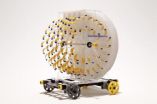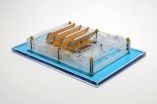(Press-News.org) New York - An immensely powerful yet invisible force pulls water from the earth to the top of the tallest redwood and delivers snow to the tops of the Himalayas. Yet despite the power of evaporating water, its potential to propel self-sufficient devices or produce electricity has remained largely untapped -- until now.
In the June 16 online issue of Nature Communications, Columbia University scientists report the development of two novel devices that derive power directly from evaporation - a floating, piston-driven engine that generates electricity causing a light to flash, and a rotary engine that drives a miniature car.
When evaporation energy is scaled up, the researchers predict, it could one day produce electricity from giant floating power generators that sit on bays or reservoirs, or from huge rotating machines akin to wind turbines that sit above water, said Ozgur Sahin, Ph.D., an associate professor of biological sciences and physics at Columbia University and the paper's lead author.
"Evaporation is a fundamental force of nature," Sahin said. "It's everywhere, and it's more powerful than other forces like wind and waves."
Last year, Sahin found that when bacterial spores shrink and swell with changing humidity, they can push and pull other objects forcefully. They pack more energy, pound for pound, than other materials used in engineering for moving objects, he reported in a paper published in Nature Nanotechnology, which was based on work Sahin had started as a Scholar in Residence at the Wyss Institute for Biologically Inspired Engineering at Harvard University.
Building on last year's findings, Sahin and his Columbia colleagues sought to build actual devices that could be powered by such energy.
To build a floating, piston-driven engine, the researchers first glued spores to both sides of a thin, double-sided plastic tape akin to that in cassette tapes, creating a dashed line of spores. They did the same on the opposite side of the tape, but offset the line so dashes on one side overlapped with gaps on the other.
When dry air shrinks the spores, the spore-covered dashes curve. This transforms the tape from straight to wavy, shortening the tape. If one or both ends of the tape are anchored, the tape tugs on whatever it's attached to. Conversely, when the air is moist, the tape extends, releasing the force. The result is a new type of artificial muscle that is controlled by changing humidity.
Sahin and Xi Chen, a postdoctoral fellow in his lab, then placed dozens of these tapes side by side, creating a stronger artificial muscle that they then placed inside a floating plastic case topped with shutters. Inside the case, evaporating water made the air humid. The humidity caused the muscle to elongate, opening the shutters and allowing the air to dry out. When the humidity escaped, the spores shrunk and the tapes contracted, pulling the shutters closed and allowing humidity to build again. A self-sustaining cycle of motion was born.
"When we placed water beneath the device, it suddenly came to life, moving on its own," Chen said.
The spore-covered artificial muscles function as an evaporation-driven piston. Coupling that piston to a generator produced enough electricity to cause a small light to flash.
"We turned evaporation from a pool of water into light," Sahin said.
With its current power output, the floating evaporation engine could supply small floating lights or sensors at the ocean floor that monitor the environment, Chen said, speculating that an improved version with stickier plastic tape and more spores could potentially generate even more power per unit area than a wind farm.
The Columbia team's other new evaporation-driven engine - the Moisture Mill - contains a plastic wheel with protruding tabs of tape covered on one side with spores. Half of the wheel sits in dry air, causing the tabs to curve, and the other half sits in humid environment, where the tabs straighten. As a result, the wheel rotates continuously, effectively acting as a rotary engine.
The researchers next built a small toy car, powering it with the Moisture Mill and were successful in getting the car to roll on its own, powered only by evaporation. In the future, Sahin said, it may be possible to design engines that use the mechanical energy stored in spores to propel a full-sized vehicle. Such an engine, if achieved, would require neither fuel to burn nor an electrical battery.
A larger version of the Moisture Mill could also produce electricity, Sahin said, suggesting a wheel that sits above a large body of water and evaporates saltwater, causing the wheel to rotate and generate electricity. This development would steadily produce as much electricity as a wind turbine, Sahin said.
INFORMATION:
Sahin's work on this project was funded by the U.S. Department of Energy, Office of Science, and the David and Lucile Packard Fellows Program.
The urban mosquito that carries the dengue fever virus is hitching rides on river boats connecting the Amazonian town of Iquitos, Peru, with rural areas.
PLOS Neglected Tropical Diseases published a study by disease ecologists at Emory University, showing how the Aedes aegypti mosquito, which is normally associated with urban areas, is tapping human transportation networks to expand its range.
"The majority of large barges we surveyed were heavily infested," says Sarah Anne Guagliardo, who led the study as a PhD student in the lab of Uriel Kitron, chair of Emory's Department ...
Plants are a ubiquitous and essential part of our lives. Estimates suggest there are hundreds of thousands of plant species known to science. How many species are there, really? How are they related? How many are threatened with extinction? Answering these questions in such an enormous clade of life is an important but daunting task for scientists.
Modern molecular techniques and, in particular, next-generation sequencing provide a powerful tool set to begin uncovering these answers. DNA regions can quickly be obtained and compared across species to infer relationships ...
This news release is available in German.
They are thin, light-weight, flexible and can be produced cost- and energy-efficiently: printed microelectronic components made of synthetics. Flexible displays and touch screens, glowing films, RFID tags and solar cells represent a future market. In the context of an international cooperation project, physicists at the Technische Universität München (TUM) have now observed the creation of razor thin polymer electrodes during the printing process and successfully improved the electrical properties of the printed ...
This news release is available in French. A multidisciplinary group of researchers from British Columbia has developed a participatory action research program to help address healthy body weight in children.
The SCOPE (Sustainable Childhood Obesity Prevention through Community Engagement) program has a simple message and was developed to engage communities to take action to prevent childhood obesity. The first phase of the SCOPE program was funded by Child Health BC, an initiative of BC Children's Hospital, and was carried out in communities in British Columbia. The ...
Alexandria, VA - From the tiny microcosms of atomic theory and futuristic colonies on Mars to dinosaurs walking the Earth, science illustrators translate scientific findings and theories into something lifelike, accurate and aesthetically pleasing. The July cover story from EARTH Magazine, "Science Illustrators: Making the Invisible Visible," takes readers on a behind-the-scenes of how illustrators transform a scientific concept into an informed work of art.
Scientific illustrating is informed as much by researching the scientific literature as it is by the imagination. ...
COLUMBUS, OHIO - Imagine getting a sudden boost in status at work that changes you from a largely ignored worker to someone that others turn to for advice and help.
Sounds great, doesn't it? But a new study finds that an unanticipated gain in status can come with some negative baggage - if you did not earn the boost.
Researchers studied American employees of a Japanese firm who didn't enjoy particularly high status with the company - until it adopted English as its official language. Then, all of a sudden, Japanese employees who didn't speak English had to rely a ...
Preschoolers with oppositional defiant behavior are more likely to have shorter telomeres, a hallmark of cellular aging, which in adults is associated with increased risk for chronic diseases and conditions like diabetes, obesity and cancer.
This phenomenon was uncovered by UCSF researchers, who also identified maternal clinical depression as an independent predictor for shortened telomeres in young children, according to a study published on Tuesday in the journal Translational Psychiatry.
Likened to the plastic tips of shoelaces, telomeres cap the ends of chromosomes ...
Up to 80 percent of individuals with a past history of depression will get depressed again in the future. However, little is known about the specific factors that put these people at risk. New research suggests that it may be due to the things you pay attention to in your life.
Researchers at Binghamton University recruited 160 women -- 60 with a past history of depression, 100 with no history of depression. They showed each woman a series of two faces, one with a neutral expression and the other with either an angry, sad or happy expression. Using eye-tracking, they ...
WASHINGTON - While the U.S. inland waterways system covers a vast geographic area, its freight traffic is highly concentrated, and the system needs a sustainable and well-executed plan for maintaining system reliability and performance to ensure that its limited resources are directed where they are most essential, says a new report from the National Research Council's Transportation Research Board. More targeted operations and maintenance (O&M) investments informed by an asset management approach would prioritize locks and facilities that are most in need of maintenance ...
Although most citizens tend to believe that big business owns Washington D.C., a team of researchers suggests that business may have a less dominant and more complicated relationship with government than previously thought.
In a study of randomly selected federal policy decisions between 1998 and 2002, the researchers found that when citizen interest groups and other competitors opposed businesses on policies, businesses had roughly an equal chance of success as the citizen group. When the researchers examined a shorter time period, businesses were only successful about ...





